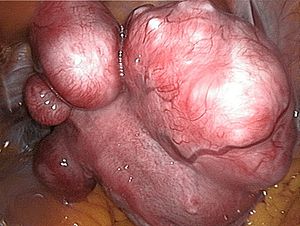by Dr. Rita Louise
Uterine fibroids Latina: Uterus myomatosus (Photo credit: Wikipedia)
Uterine fibroids are the most common benign (non-cancerous) tumor found in women. As many as three out of four women have uterine fibroids. In most cases, they present no problems and do not require any treatment at all. In fact, most women are unaware they have fibroids, because fibroids often do not cause any symptoms.
Fibroids form in the muscle tissues of the uterus. They start out as an irregular cell in the muscle layer of the uterus and slowly grow into a tumor-like mass of connective tissue. The can develop as a single growth, or grow in clusters. Their size can range from that of an apple seed to larger than a grapefruit.
Some fibroids grow within the smooth muscle of the uterus, others grow on the inner uterine lining, while others grow on the outer surface of the uterus. In some instances, a uterine fibroid can grow on a stalk, called a peduncle, which grows out from the surface of the uterus either into the uterus proper or into the abdominal cavity.
Again, while most women do not have any indication they have uterine fibroids, the ones that do can experience a variety of symptoms including heavy, painful or prolonged menstrual cycles, bleeding between cycles, pain during sex, pelvic pressure, incontinence or frequent urination, constipation, backaches or even leg pain.
Researchers are unsure of what causes fibroids, but it is believed that hormones, genetics and the environment all contribute to their development. Scientists have not identified what “initiates” the growth of a fibroid; however, they do feel as if there may be some kind of genetic predisposition to fibroid growth. It is also theorized that the hormones estrogen, progesterone and growth factors promote (not initiate) the growth of a tumor, since fibroids can begin forming as early as 20 years of age. They often begin to shrink after menopause.
If you are a woman and either have fibroids or believe you may have fibroids, there are a large number of natural remedies and alternative health therapies you can try to help reduce the size of a uterine fibroid and even eliminate them completely.
Recommendations For Wellness
* Limit your exposure to foods or products that contain estrogen. This includes estrogen-mimicking residues from herbicides and pesticides and excess estrogen found in animal products. Birth control pills and hormone replacement therapy are also sources of female hormones and should be eliminated or replaced with a safer yet effective substitute.
* Reduce your sugar, coffee and alcohol intake.
* Reduce your stress level. Exercising and using techniques that reduce stress, such as meditation, yoga or even biofeedback, can help to relieve the symptoms of fibroids.
* The herbs milk thistle, burdock and dandelion are excellent liver supporting herbs that assist the body’s natural ability to detoxify estrogen from the body.
* In addition to helping promote liver health and detoxification, yellow dock is high in iron and is useful if anemia is a problem due to blood loss.
* Like yellow dock, nettles are also rich in iron and are good for building healthy blood and relieving anemia.
* A tincture of chaste tree taken over a long period of time has been known to shrink small fibroids. Chaste tree is helpful in balancing the female reproductive system.
* The herb wild yam has historically been used to maintain a balance of hormones within the body. It contains plant hormone precursors which help in the production and balancing of progesterone.
This information is provided for educational purposes only.



